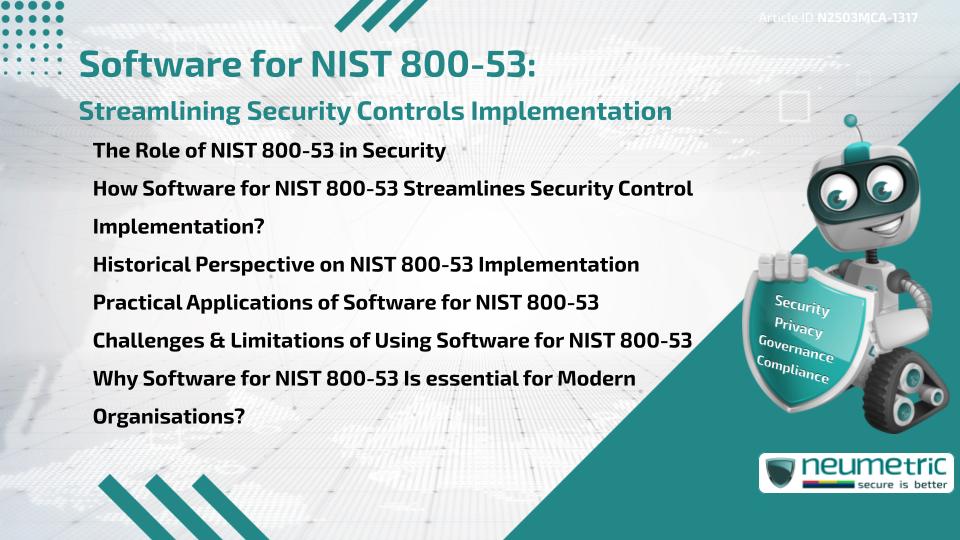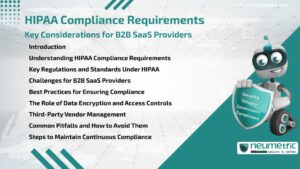Table of Contents
ToggleIntroduction
The National Institute of Standards & Technology [NIST] Special Publication 800-53 provides a set of guidelines designed to help Organisations secure their Information Systems. These guidelines are vital for those in Government & Regulated Industries, but applying them can be a daunting task. This is where Software for NIST 800-53 comes in. By automating many of the processes involved, Organisations can streamline the implementation & ongoing management of these Security Controls, reducing Risk & ensuring Compliance with Federal & Industry Standards. In this article, we will explore how Software for NIST 800-53 can improve security, the challenges it addresses & why it is essential for Modern Organisations.
The Role of NIST 800-53 in Security
Before delving into the Software itself, it is important to understand what NIST 800-53 is all about. The Document outlines a comprehensive Framework of Security Controls designed to protect Federal Information Systems. These Controls are organised into Eighteen (18) Control families, including areas like Access Control, Incident Response & System & Communications Protection. The Goal is to safeguard Sensitive Information, protect the Confidentiality, Integrity & Availability of systems & maintain continuous Risk Management.
How Software for NIST 800-53 Streamlines Security Control Implementation?
Automation of Control Management
One of the key benefits of using Software for NIST 800-53 is automation. Many of the processes required for managing Security Controls—such as Monitoring, Testing & Reporting—can be time-consuming & error-prone when done manually. Software Tools can automate these processes, ensuring consistency, reducing human error & speeding up implementation. For example, Automated Tools can perform regular Vulnerability Scans, Track Control effectiveness & generate Compliance Reports in real time.
Simplified Documentation & Reporting
Documentation is a critical part of NIST 800-53 Compliance. For each control, Organisations need to record how they are implemented, tested & maintained. This can be an overwhelming task, especially for Large Organisations. Software for NIST 800-53 can simplify this by offering templates & centralised storage for documentation. Reports can be generated quickly, providing Stakeholders with clear insights into Security Posture, Audit Trails & Compliance Status.
Improved Risk Management
By continuously Tracking & Assessing Security Controls, Software Tools provide a more dynamic view of an Organisation’s Risk Management strategy. They help identify Gaps in coverage, highlight Areas for Improvement & support Decision-making based on Real-time Data. This proactive approach is far more effective than relying on periodic Audits or static Risk Assessments.
Historical Perspective on NIST 800-53 Implementation
Historically, Organisations have struggled to manage NIST 800-53 manually due to the sheer volume of Controls & the complexity of the Documentation required. In the past, this often led to Compliance Delays, Security Gaps & a lack of Transparency. As the importance of Cybersecurity grew, so did the need for more efficient tools to help Organisations meet the rigorous requirements of NIST 800-53.
In earlier years, Security Professionals had to rely on Spreadsheets, Paper Records & Manual Processes to Track Compliance, which often resulted in inefficient workflows. Today, Software Tools are specifically designed to address these challenges, ensuring smoother compliance processes, fewer mistakes & better integration with other Security Systems.
Practical Applications of Software for NIST 800-53
Small to Medium Enterprises [SMEs]
For Small to Medium Enterprises [SMEs] that lack Large IT Security Teams, Software for NIST 800-53 can be a game changer. It offers an affordable & effective way to manage Controls & stay Compliant with minimal resources. With automated features, these Organisations can manage their security without the need for Full-time Compliance Experts.
Large Organisations & Government Agencies
For Large Enterprises or Government Agencies with extensive Networks & complex IT Systems, the scalability of Software for NIST 800-53 is essential. These tools can handle vast amounts of data, manage multiple users & track numerous Security Controls simultaneously. Moreover, they ensure consistent compliance across diverse Departments & Locations.
Challenges & Limitations of using Software for NIST 800-53
Complexity of Setup
While Software Tools can make ongoing management of NIST 800-53 easier, the initial setup can be complex. Configuring the system to align with an Organisation’s specific Security Requirements & Control Environment may require a fair amount of customisation. Some Organisations may need to invest time in training Staff & aligning Software Functionality with Business processes.
Over-reliance on Automation
Another potential downside is the over-reliance on Automation. While automation can significantly reduce human error & speed up processes, it is still important for Security Professionals to actively monitor & evaluate the results. Overlooking manual checks or relying solely on automated systems could lead to missed Vulnerabilities or incorrect Reports.
Why Software for NIST 800-53 Is essential for Modern Organisations?
The increasing sophistication of Cyber Threats & the evolving Regulatory Landscape means that managing Security Controls effectively is no longer optional—it is a necessity. Using Software for NIST 800-53 offers Organisations a way to stay ahead of threats, reduce compliance costs & create a secure IT environment that is both efficient & sustainable. With Automation, Real-time Monitoring & Simplified Documentation, these tools provide a strategic advantage for companies committed to securing their Systems & Data.
Conclusion
In today’s fast-paced & ever-evolving digital world, the importance of a robust Security Framework cannot be overstated. NIST 800-53 serves as a critical standard for Securing Federal Information Systems & using the right Software for its implementation can make a significant difference in how Organisations manage their Security Controls. By leveraging Automation, improving Risk Management & streamlining Compliance, Software Tools for NIST 800-53 enable Businesses to meet the demands of a modern security landscape.
Takeaways
- Software for NIST 800-53 automates many aspects of Control Management, reducing manual effort & improving efficiency.
- By simplifying Documentation & Reporting, the Software ensures Compliance without unnecessary complexity.
- The Software helps Organisations proactively manage Risk by continuously monitoring control effectiveness.
- While powerful, it is important to properly configure Software & maintain manual oversight to avoid potential pitfalls like over-reliance on Automation.
FAQ
What is NIST 800-53?
NIST 800-53 is a set of guidelines developed by the National Institute of Standards & Technology to help Organisations secure their Information Systems & Data. It consists of a comprehensive list of Security Controls designed to address various Risks & Threats.
How does Software for NIST 800-53 improve Compliance?
Software Tools for NIST 800-53 automate key tasks like Monitoring, Reporting & Risk Assessment, which helps Organisations maintain Continuous Compliance with NIST’s Security Requirements, reducing the likelihood of human error.
Can Small Businesses benefit from Software for NIST 800-53?
Yes, Small Businesses can benefit from these tools by automating Compliance Tasks, reducing costs & making it easier to meet Regulatory Standards without needing a large IT Security Team.
What are the challenges of using Software for NIST 800-53?
Challenges include the Initial setup complexity, potential need for customisation & the risk of over-relying on Automation without sufficient Manual Oversight or Review.





